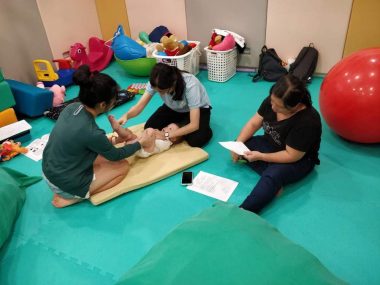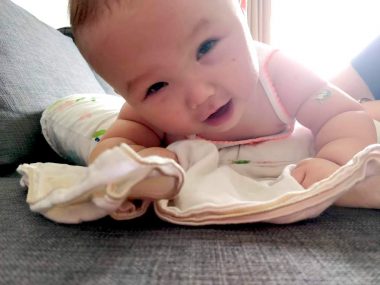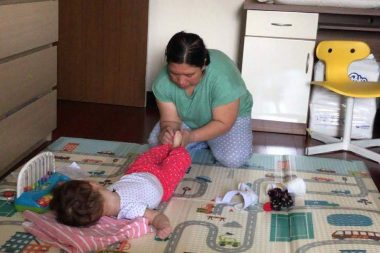The Benefits of Massage for AADC-deficient Children

Beneath my daughter’s skin, I know there are muscles, and deeper still is the desire to move. I know it’s there, but despite my willing her to move, she can only stare back. Sometimes I cannot meet her eyes, and my stomach twists, knowing I have no answers for her. I cannot help her. I cannot stop the pain. I cannot give her the life she deserves.
For the first few years of Rylae-Ann’s life, this was our reality, as it is for many other parents in the aromatic l-amino acid decarboxylase (AADC) deficiency community. What can we do for our children when there is no cure, and medication does very little to soothe their pain?
One method that calmed our daughter was free and with us all along: My wife, Judy, would use her hands to instinctively massage Rylae-Ann before bed every night. We saw that it worked well, and we wanted to learn more. Judy began attending baby massage classes regularly and learning online.
Massage
The power of massage has a long history and culture in Asia, where we now live. It dates back more than 5,000 years and has long been a sacred practice in China, India, and Egypt. Today, a monthly massage is covered under our insurance plan and seen as a routine part of life for many in Thailand. Maybe one reason my wife knew it would work so well was because she has also benefited from regular massages.
Massage therapy can enhance children’s wellness. Medication did little to help manage our daughter’s symptoms, but massage did wonders. Massage therapy involves pressing, rubbing, and manipulating the skin, muscles, tendons, and ligaments. We never provided deep pressure for our daughter, who had low muscle tone. Instead, it ranged from light stroking to gentle pressure.
Our method
Massage therapy can potentially ease pain and muscle weakness. While starting out, we concentrated on muscles used for breathing and eating, as AADC-deficient children struggle to thrive. Our daughter benefited from daily massages in multiple ways. You will want to talk with your therapist about the various types available. Each has unique properties and effects. You can switch to different methods or choose the style that best matches your child’s preferences. Following are the methods that worked for our daughter.
Sensory integration
Another important benefit of massage was sensory integration. At first, Rylae-Ann was sensitive to massage, and it was too much stimulation. Judy started with light touches for short periods while I held something entertaining in front of her. Later, it became a more calming experience, which we did before bed. Your child may not like massage when first starting out, so begin by getting comfortable with the location where you will do the massage and do light, playful taps.

During a sensory integration session, the therapist introduces techniques and a guidebook to support Rylae-Ann’s family in doing massage at home. (Photo by Richard E. Poulin III)
Hands and feet
When we first noticed our daughter’s symptoms, my wife began massaging her while we looked for answers. Thankfully, we initiated massage very early on. Judy began massaging our daughter periodically throughout the day by combining what she knew about massage for herself and what she learned about baby massage online.
Judy started with the feet and hands, partly because these areas looked tight. Our daughter always seemed to have a clenched fist and missed her milestone of reaching out. When Rylae-Ann woke up, Judy would coax her muscles with light massages on the bottom of her feet, then her ankles, and finally up each leg. Then she would open her hand and massage the palm and fingers before doing the other hand. Massage sessions throughout the day became routine.
Later, she was able to do other areas like the stomach. Due to autonomic dysfunction, Rylae-Ann had trouble using the bathroom regularly. Sometimes it lasted for days, and other times it came in the form of a “poonami.” The massage, we believe, helped to soothe the pain and improve her digestion.
After an oculogyric crisis — when the gaze is involuntarily fixed upward due to spasms in the eye muscles that support eye movement — Judy would try to ease Rylae-Ann’s muscles from the dystonic movements and help her to sleep.

Rylae-Ann’s mother began by massaging her feet and hands to help ease symptoms and build her tolerance to the sensations of massage. (Photo by Richard E. Poulin III)
Facial and oral massage
As my wife’s knowledge and confidence grew, she began to incorporate facial and oral massage using a combination of techniques she learned from a speech therapist and from online courses.
Facial and oral massages proved crucial in eventually helping our daughter to talk. Low muscle tone in the face also makes eating very difficult. We learned that many children have speech disorders as a result of being unable to control the muscles that allow articulation. This includes the cheeks, lips, tongue, throat, and core. After gene therapy, we continued facial massage to help improve Rylae-Ann’s speech and reduce drooling.
Building core
The goal is to have children become comfortable with a back massage while lying on a burpee. While you massage the muscles and help improve blood flow, your child will work their core. We did not achieve this for several years after implementing a routine for the less challenging areas. Concentrating more on this area may have even helped us to prevent Rylae-Ann from having a dislocated hip.

Over time, Rylae-Ann was able to have a back massage while also doing belly time to help her core. (Photo by Richard E. Poulin III)
Conclusions
There are many different massage techniques and styles, and you must talk with your physical therapist about which will suit your child. By looking at other rare disease communities with similar symptoms, you will find plenty of resources and reviews.

Rylae-Ann’s nanny learned massage techniques to provide additional massage sessions during the day. (Photo by Richard E. Poulin III)
Massage can help your child feel better physically, mentally, and emotionally, but take your time and gauge your movements based on their response. Experiment with different massage types and different massage therapists to find the best match. For us, this has always been Mom, but we taught Grandma and Rylae-Ann’s nanny how to help as well.
Note: AADC News is strictly a news and information website about the disease. It does not provide medical advice, diagnosis, or treatment. This content is not intended to be a substitute for professional medical advice, diagnosis, or treatment. Always seek the advice of your physician or other qualified health provider with any questions you may have regarding a medical condition. Never disregard professional medical advice or delay in seeking it because of something you have read on this website. The opinions expressed in this column are not those of AADC News or its parent company, Bionews, and are intended to spark discussion about issues pertaining to aromatic l-amino acid decarboxylase deficiency.








Leave a comment
Fill in the required fields to post. Your email address will not be published.